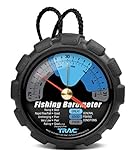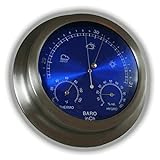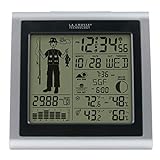Disclosure: Some posts contain affiliate links, which earn us a commission if you make a purchase through them. Positive Fishing © participates in various affiliate networks including the Amazon Services LLC Associates Program.
Fish are sensitive creatures, and understanding their sensitivities and reactions to them is key to every angler’s fishing success.
We all know about how temperatures affect fish behavior, if it is too hot they go deep and feed slowly, if it is too cold they do the same, and we adapt our fishing tactics accordingly. But what about barometric pressure?
Barometric pressure is another thing anglers need to consider when it comes to fish behavior and fishing success. However, anglers often overlook it since understanding and measuring it all is complicated and time-consuming.
In this article, I will run through the basics of barometric pressure, what it is, how it affects fish, choosing the best barometers from an angling perspective, and how to use them for fishing so you can catch more fish than ever.
What Is Barometric Pressure?
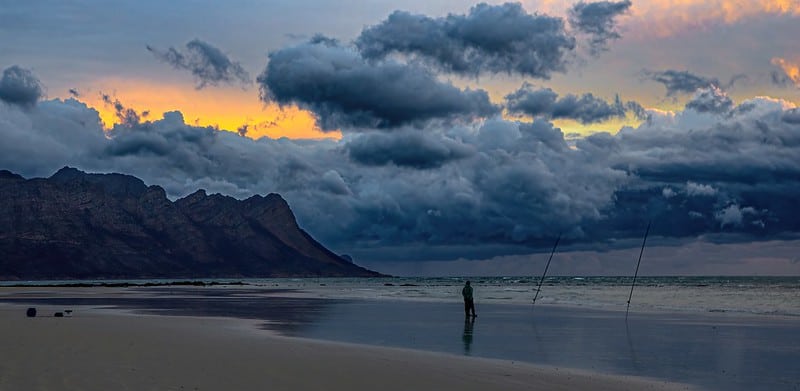
Barometric pressure, also referred to as air pressure or atmospheric pressure, is essentially the weight of the Earth’s atmosphere pressing down upon every inch of the planet. It is created by the Earth’s gravitational pull, pulling down the air around it to hold the atmosphere in place.
Now, we can’t feel the weight of the atmosphere upon us as we are used to it, but it is actually quite heavy, and a square-inch column of the atmosphere from the sea to the top weighs around 14.7 lbs. This is how much pressure we are under while we walk around at sea level.
How Is Barometric Pressure Measured?
Barometric pressure can be measured with a barometer and in a few different types of units. A barometer either uses atmospheres (atm), inches of mercury (inHg), Pascals (Pa), or bars (bar) (which is often used in diving) to measure the pressure.
A barometer should be seen as a barometric pressure weighing scale that increases its units during high-pressure systems and decreases its units when low-pressure systems are coming or have arrived.
You will notice the barometer rising, falling, or staying the same, indicating the weather conditions and fish behavior.
How Does Barometric Pressure Affect Fishing?
Now that we understand what barometric pressure is, how it changes, and how to read it, let’s look at the more interesting side: how barometric pressure affects fish.
Now, to fully understand how barometric pressure affects fish, we need to think about barometric pressure as affecting gravity in the water that the fish live in. Since water is such a dense substance, the effect of gravity and pressure is greatly increased.
Pressure Changes Cause Food Depth Changes
When the barometric pressure drops, so does the effect of gravity on what is in the water as it is slightly lessened. This allows small particles in the water to rise up through the water column, and this includes zooplankton and phytoplankton, which are the beginning of every food chain in the water.
When the zooplankton and phytoplankton rise to the surface, the smaller baitfish and anything else that feeds on them follow them to the surface, too, and so do the predators you intend to catch.
I have often seen bait balls of yellow-fin tuna on the surface and usually in cloud conditions due to the plankton floating to the surface.
The same thing happens, except in reverse, when you have a high-pressure system. As the zooplankton and phytoplankton sink deeper, fish will follow the food down to this depth.
Fish Feel The Pressure Changes
Using their lateral lines and their swim bladders, fish can detect the slight changes in barometric pressure, and their reactions to this change are closely related to what conditions the changes bring.
Pressure changes usually mean a change in the stability of the environment in the form of either adverse weather with low pressure or hot weather with lots of light in high-pressure conditions. This can affect visibility, water temperature, light conditions, and more, giving rise to uncertain times in the future.
This is why fish tend to “strap on the feed bag” during a pressure change, as they want to eat as much as they can before the unknown, new conditions arrive, which might mean they can’t eat as well for a few days.
The fact that this survival requirement to feed coincides with the plankton movement we discussed above means that the fish have a ton of food to gorge on at a time when they want to eat a lot, and thus, the fishing can be amazing when this happens.
You should also know that fish in shallow water feel changes in barometric pressure much more than fish in deep water. This means a trout in a shallow river will change its behavior based on air pressure much more than a trout sitting at the bottom of a deep lake.
What Are The Best Barometric Conditions To Go Fishing?
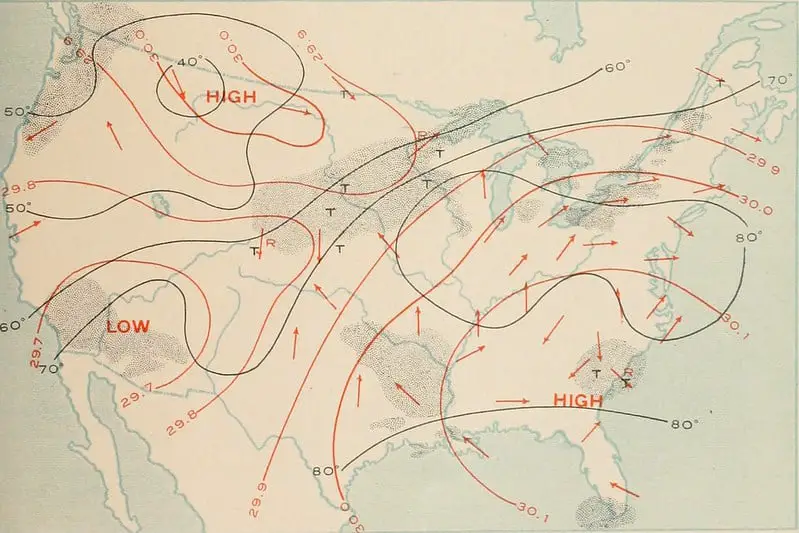
Since fish change their behaviors based on different barometric pressure conditions, let’s look at how they do so across each type of condition or change so you can use barometric conditions to your advantage.
Pressure is not the only criteria in determining the chances of catching fish, the length of time of the high or low-pressure period can be a factor.
Changes
As you can see, fishing during a change of barometric pressure is a highly desirable time to be
on the water as the fish really do go for it. This is when you want to be fishing aggressively with active baits such as lures, live baits, or worms, to match the activity of the fish.
Stability
That being said, another of the best times to be fishing is when the barometric pressure has been stable for 3 days or longer. This allows the fish to get into a good routine and find their preferred water level, oxygen content, amount of light, and more, which causes them to feed more regularly and without worry.
High Pressure
In high-pressure systems, there is more weight on the water and, therefore, more gravity at play. This means smaller particles, such as zooplankton and phytoplankton, will sit a bit deeper; therefore, the fish will be, too.
High pressure also equals sunshine and warmth in most cases, and since most fish do not have eyelids, they will sit a bit deeper to avoid having the sun in their eyes. Also, the surface water temperature may increase too much for the fish’s comfort, causing them to swim deeper and find a preferred water temperature.
Of course, this can have the opposite effect when the water has been too cold and needs warming up, like in springtime.
Low Pressure
Low-pressure systems provide less gravity, so things like zooplankton and phytoplankton will be near the surface. It also means baitfish and the predators you want to catch will likely be there.
Low pressure can also mean cloudy weather and a cooling effect on the water temperature, which can be good or bad. If you are trout fishing, clouds are great as fish sit deep to avoid direct sun in their eyes.
If it has been a hot summer and you suddenly get some rain and clouds, this can turn the fishing on, but it can have the reverse effect if the water temperature is already cold.
Barometric Chart For Best Time To Go Fishing
| Barometer Reading | Weather | Fishing Condition | Where the fish are usually |
|---|---|---|---|
| 30.5+ | Clear Skies | Slow to medium | Mid depth or deeper water/near cover |
| 29.7 to 30.4 | Fair | Average fishing | At any depth |
| 29.6 or lower | Cloudy/ Raining | Fishing gets harder | Deeper water and near cover |
Barometric Change Chart Impact On Fishing Chances
| Pressure Change | Weather | Fishing Chances | |||||||||||||||||||
|---|---|---|---|---|---|---|---|---|---|---|---|---|---|---|---|---|---|---|---|---|---|
| Rising | Improving | Fish are Slow and Innactive | |||||||||||||||||||
| Stable | Fair | Good, Normal Opportunities | |||||||||||||||||||
| Falling | Worsening | The BEST Opportunities |
Fishing Barometers
There are quite a few fishing barometers on the market to choose from; some even indicate when the fishing will be poor, good, or great.
This fishing barometer does just that, and it is worth having one of these in your fishing bag so you can start matching good and bad days to atmospheric pressure and its changes. You can also get electronic barometers in watches and GPS’ so you might already own one you can start using.
What Is The Best Barometer For Fishing?
- Trac Outdoors Fishing Barometer – Our best portable Barometer Pick!
- Ambient Weather WS-228TBH 9″ Barometer – Our best contemporary Barometer Pick!
- La Crosse Technology 308-1451 Atomic Forecast Station – Our best Digital Pick!
- Suunto Core Non-GPS Outdoor Adventure Watch with Barometer, Compass, Dual Time Display – Our best watch pick!
The Trac Outdoors Fishing Barometer is an affordable entry-level portable barometer. This barometer can be carried around your neck using the provided lanyard.
- Easy to carry around
- Easy to calibrate for local barometric pressure
- Adjustable pressure change indicator
- The color-coded dial shows typical conditions for great, good, or poor fishing
- Braided lanyard
- Very affordable
The Ambient Weather WS-228TBH 9″ Brushed Aluminum Contemporary Barometer is an old-style hand on your garage wall or your shed. A quick glance on the face will tell you the current pressure status and give you a rough indication of how the fishing may work out for you.
It can read Barometric Pressure (inHg), Temperature (deg F), and Humidity (%)
- The USA version displays both barometric pressure in imperial units (inHg) and also a reference needle for tracking changes.
- It’s a 9″ brushed aluminum bezel with a blue dial and is more decorative. It’s a contemporary design for both indoor and outdoor use.
- It can be easily attached to the wall.
- Has a reference needle to track changes in barometric pressure.
- The barometer allows for sea-level calibration up to 3,000 feet only and should not be used if you live above 3,000 feet.
The La Crosse Technology 308-1451 Atomic Forecast Station has additional functions than the standard barometer, such as a trend graph and historical data tracking.
It’s ideal for putting on your office desk or at home because having multiple functions gives you an improved view of how the changes in humidity, pressure, and temperature will impact your fishing.
- Has a fisherman icon with a tendency arrow to react to changes in the temperature (current forecast)
- Indoor and Outdoor Temperature & Humidity with MIN/MAX recorded values
- 12 Hour history barometric pressure graph (inHg or hPa)
- Atomic self-setting time and date with automatic DST updates
- LED Backlight gives visibility at night
- Very easy to use
The Suunto Core Non-GPS Outdoor Adventure Watch with Barometer, Compass, Dual Time Display has an altimeter, barometer, and compass features, and if you want a device that you can easily have access to these functions on your wrist, then this is a great option for fisherman.
Make sure you review the options for the Suunto range, as some do not have a barometer function. Look for the Suunto core, Sunnto 9 baro, and the Suunto 9 peak for the barometer choices.
It is a very durable watch and is water resistant to 30 meters. Other than the barometer function, the storm alert and weather trend indicator is great for anglers.
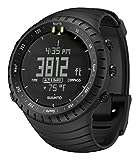
- Multiple features like a Storm Alarm, Altimeter, Barometer, and compass to monitor conditions while you do outside sports such as fishing.
- The watch has a dual time function, a date display, and an alarm. The prediction time for sunrise and sunset will help anglers plan their fishing start and end times
- Durable and full of features to use even when you are not fishing.
- Suunto has 80 years of experience in watches, compasses, and dive products
Barometric Pressure FAQ
Is Barometric Pressure The Same Everywhere On Earth?
Everywhere at sea level will have the same barometric pressure so long as they have the same weather conditions. When you change altitudes and go higher, like when fishing on the rocky mountains, the barometric pressure reduces, and you are under less weight since you are closer to the top.
What Causes The Barometric Pressure To Change?
The changes in barometric pressure come from a combination of changing winds, air temperatures, and the Earth’s rotation. These come together to create either high-pressure weather systems or low-pressure weather systems.
It is usually warmer in a high-pressure weather system; the sky is clear, and the air presses close to the earth’s surface, increasing the barometric pressure.
In a low-pressure system, it is usually a colder, cloudy day with a chance of rain where the air isn’t pressed next to the earth as much as it is held higher in the sky. This type of system has low barometric pressure.
This is how sailors use barometers to detect weather changes; if the barometric pressure starts dropping quickly, it is a sure sign of some cold, bad weather coming in the form of a low-pressure system. If the barometric pressure goes up, it is a sign of good weather coming.
Airing Up
Thanks very much for reading my article. I hope you enjoyed it and now understand barometric pressure, how it affects fish, and how using one can improve your fishing chances. Of course, it is not an exact science, as other conditions, such as the importance of water pH level, can also affect your fishing chances, but it is a factor you should keep your eye on.
Our best portable barometer, the Trac Outdoors Fishing Barometer, is an ideal unit suited for fishermen and is a very affordable option. If you don’t already own a watch specifically for outdoor sports use, then go for the Suunto Core.
Please share this article with your fishing buddies, and why not look at some of our others, such as our in-depth review on the best jackets and suits for fishing in the rain and cold.
- What Are Fish Scales & Slime: Exploring Their Crucial Roles In Fish - January 22, 2024
- Tench Fishing: Tactics & Tips For Landing The Elusive Tinca Tinca - January 18, 2024
- What Is The Strongest Fishing Rod? - January 13, 2024

